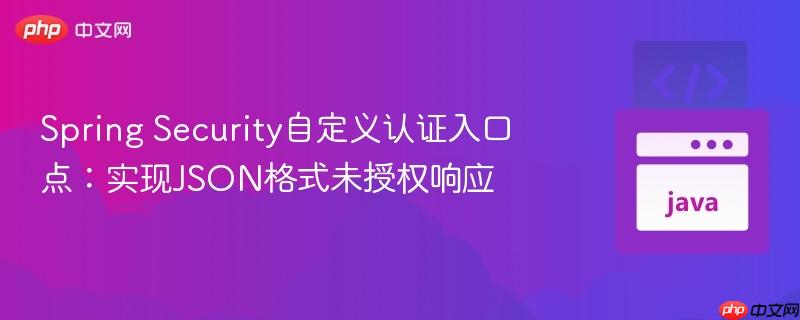
spring security默认的认证失败响应是html页面。本教程将指导如何通过实现自定义的authenticationentrypoint来拦截401未授权错误,并将其转换为统一的json格式响应,从而提供更友好的api错误处理机制。内容涵盖配置securityconfiguration、编写customauthenticationentrypoint以及相应的单元测试,确保api客户端能正确解析错误信息。
在构建RESTful API时,客户端通常期望接收结构化的错误响应,例如JSON格式,而不是Web服务器生成的HTML错误页面。然而,Spring Security在处理用户未认证(HTTP 401 Unauthorized)的请求时,其默认行为是返回一个包含HTML内容的错误页面。这对于Web应用可能尚可接受,但对于API客户端来说,解析HTML以获取错误详情既不高效也不方便。
例如,当未认证用户访问受保护资源时,Spring Security可能返回类似以下内容的HTML响应:
<!doctype html>
<html lang="en">
<head>
<title>HTTP Status 401 – Unauthorized</title>
<!-- ... 省略样式 ... -->
</head>
<body>
<h1>HTTP Status 401 – Unauthorized</h1>
</body>
</html>而API客户端通常期望得到的是类似以下JSON格式的错误响应:
{
"errors": [
{
"status": "401",
"title": "UNAUTHORIZED",
"detail": "认证失败,请提供有效的凭据。"
}
]
}为了满足这一需求,我们需要定制Spring Security的认证入口点(AuthenticationEntryPoint)。
AuthenticationEntryPoint是Spring Security提供的一个核心接口,用于处理未经认证的请求。当用户尝试访问受保护资源但未提供有效凭据时,或者提供的凭据无法通过认证时,Spring Security会调用配置的AuthenticationEntryPoint的commence方法。
commence方法签名如下:
void commence(HttpServletRequest request, HttpServletResponse response,
AuthenticationException authException) throws IOException, ServletException;在该方法中,我们可以对HttpServletResponse进行操作,例如设置HTTP状态码、添加响应头,以及最重要的——写入自定义的响应体。
要实现JSON格式的未授权响应,关键在于在CustomAuthenticationEntryPoint中直接向HttpServletResponse的输出流写入JSON数据,而不是使用response.sendError()。response.sendError()方法通常会委托给Servlet容器来生成错误页面,这会导致返回HTML。
以下是一个实现自定义AuthenticationEntryPoint的示例:
import com.fasterxml.jackson.databind.ObjectMapper; // 推荐使用Jackson进行JSON序列化
import jakarta.servlet.ServletException;
import jakarta.servlet.http.HttpServletRequest;
import jakarta.servlet.http.HttpServletResponse;
import org.springframework.http.HttpStatus;
import org.springframework.http.MediaType;
import org.springframework.security.core.AuthenticationException;
import org.springframework.security.web.AuthenticationEntryPoint;
import org.springframework.stereotype.Component;
import java.io.IOException;
import java.util.Collections;
import java.util.Map;
@Component
public class CustomAuthenticationEntryPoint implements AuthenticationEntryPoint {
private final ObjectMapper objectMapper = new ObjectMapper(); // 用于JSON序列化
@Override
public void commence(HttpServletRequest request, HttpServletResponse response,
AuthenticationException authException) throws IOException, ServletException {
// 设置响应内容类型为JSON
response.setContentType(MediaType.APPLICATION_JSON_VALUE);
// 设置HTTP状态码为401 Unauthorized
response.setStatus(HttpStatus.UNAUTHORIZED.value());
// 对于Basic认证,通常需要添加WWW-Authenticate头
response.addHeader("WWW-Authenticate", "Basic realm=\"Realm\"");
// 构建自定义的错误响应体
// 实际项目中可以定义一个专门的ErrorResponse DTO
Map<String, Object> errorDetails = Map.of(
"status", HttpStatus.UNAUTHORIZED.value(),
"title", HttpStatus.UNAUTHORIZED.getReasonPhrase(),
"detail", authException.getMessage() != null ? authException.getMessage() : "认证失败,请提供有效凭据。"
);
Map<String, Object> errorResponse = Collections.singletonMap("errors", Collections.singletonList(errorDetails));
// 使用ObjectMapper将Map转换为JSON字符串并写入响应
objectMapper.writeValue(response.getWriter(), errorResponse);
}
}代码解析:
接下来,我们需要在Spring Security的配置类中注册这个自定义的AuthenticationEntryPoint。这通常在继承WebSecurityConfigurerAdapter(或使用SecurityFilterChain)的配置类中完成。
import org.springframework.context.annotation.Bean;
import org.springframework.context.annotation.Configuration;
import org.springframework.http.HttpMethod;
import org.springframework.security.config.annotation.web.builders.HttpSecurity;
import org.springframework.security.config.annotation.web.configuration.EnableWebSecurity;
import org.springframework.security.web.SecurityFilterChain;
@Configuration
@EnableWebSecurity
public class SecurityConfiguration {
private final CustomAuthenticationEntryPoint customAuthenticationEntryPoint;
// 通过构造器注入自定义的AuthenticationEntryPoint
public SecurityConfiguration(CustomAuthenticationEntryPoint customAuthenticationEntryPoint) {
this.customAuthenticationEntryPoint = customAuthenticationEntryPoint;
}
@Bean
public SecurityFilterChain securityFilterChain(HttpSecurity httpSecurity) throws Exception {
httpSecurity
.csrf(csrf -> csrf.disable()) // 禁用CSRF,通常RESTful API不需要
.authorizeHttpRequests(authorize -> authorize
.requestMatchers(HttpMethod.GET, "/**").permitAll() // 允许GET请求无需认证
.anyRequest().authenticated() // 其他所有请求需要认证
)
.httpBasic(httpBasic -> {}) // 启用HTTP Basic认证
.exceptionHandling(exceptionHandling -> exceptionHandling
// 注册自定义的AuthenticationEntryPoint
.authenticationEntryPoint(customAuthenticationEntryPoint)
);
return httpSecurity.build();
}
}注意: Spring Security 5.7.0-M2及更高版本推荐使用SecurityFilterChain和Lambda DSL进行配置,而不是继承WebSecurityConfigurerAdapter。上述代码已更新为现代Spring Security的配置方式。
为了确保自定义的认证入口点按预期工作,编写一个单元测试是必不可少的。我们可以使用Spring的MockMvc来模拟HTTP请求并验证响应。
package com.example.security.custom.entrypoint;
import org.junit.jupiter.api.Test;
import org.springframework.beans.factory.annotation.Autowired;
import org.springframework.boot.test.autoconfigure.web.servlet.WebMvcTest;
import org.springframework.context.annotation.Import;
import org.springframework.test.web.servlet.MockMvc;
import static org.springframework.test.web.servlet.request.MockMvcRequestBuilders.post;
import static org.springframework.test.web.servlet.result.MockMvcResultHandlers.print;
import static org.springframework.test.web.servlet.result.MockMvcResultMatchers.*;
// 指定需要测试的Web层组件,并导入SecurityConfiguration
@WebMvcTest // 仅加载Web层相关的bean
@Import({SecurityConfiguration.class, CustomAuthenticationEntryPoint.class}) // 导入安全配置和自定义入口点
class SecurityCustomEntrypointApplicationTests {
@Autowired
private MockMvc mvc;
@Test
void testUnauthorizedResponseIsJson() throws Exception {
mvc
.perform(post("/somewhere")) // 发送一个POST请求到任意受保护的路径,但不提供认证凭据
.andDo(print()) // 打印请求以上就是Spring Security自定义认证入口点:实现JSON格式未授权响应的详细内容,更多请关注php中文网其它相关文章!

每个人都需要一台速度更快、更稳定的 PC。随着时间的推移,垃圾文件、旧注册表数据和不必要的后台进程会占用资源并降低性能。幸运的是,许多工具可以让 Windows 保持平稳运行。

Copyright 2014-2025 https://www.php.cn/ All Rights Reserved | php.cn | 湘ICP备2023035733号